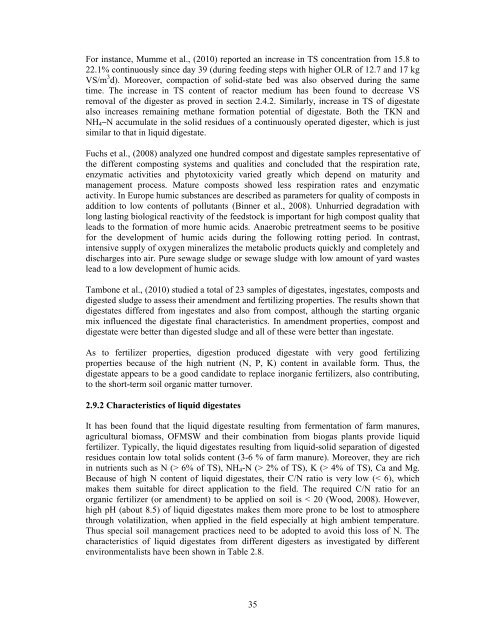dry anaerobic digestion of municipal solid waste and digestate ...
dry anaerobic digestion of municipal solid waste and digestate ...
dry anaerobic digestion of municipal solid waste and digestate ...
You also want an ePaper? Increase the reach of your titles
YUMPU automatically turns print PDFs into web optimized ePapers that Google loves.
For instance, Mumme et al., (2010) reported an increase in TS concentration from 15.8 to<br />
22.1% continuously since day 39 (during feeding steps with higher OLR <strong>of</strong> 12.7 <strong>and</strong> 17 kg<br />
VS/m 3 d). Moreover, compaction <strong>of</strong> <strong>solid</strong>-state bed was also observed during the same<br />
time. The increase in TS content <strong>of</strong> reactor medium has been found to decrease VS<br />
removal <strong>of</strong> the digester as proved in section 2.4.2. Similarly, increase in TS <strong>of</strong> <strong>digestate</strong><br />
also increases remaining methane formation potential <strong>of</strong> <strong>digestate</strong>. Both the TKN <strong>and</strong><br />
NH4–N accumulate in the <strong>solid</strong> residues <strong>of</strong> a continuously operated digester, which is just<br />
similar to that in liquid <strong>digestate</strong>.<br />
Fuchs et al., (2008) analyzed one hundred compost <strong>and</strong> <strong>digestate</strong> samples representative <strong>of</strong><br />
the different composting systems <strong>and</strong> qualities <strong>and</strong> concluded that the respiration rate,<br />
enzymatic activities <strong>and</strong> phytotoxicity varied greatly which depend on maturity <strong>and</strong><br />
management process. Mature composts showed less respiration rates <strong>and</strong> enzymatic<br />
activity. In Europe humic substances are described as parameters for quality <strong>of</strong> composts in<br />
addition to low contents <strong>of</strong> pollutants (Binner et al., 2008). Unhurried degradation with<br />
long lasting biological reactivity <strong>of</strong> the feedstock is important for high compost quality that<br />
leads to the formation <strong>of</strong> more humic acids. Anaerobic pretreatment seems to be positive<br />
for the development <strong>of</strong> humic acids during the following rotting period. In contrast,<br />
intensive supply <strong>of</strong> oxygen mineralizes the metabolic products quickly <strong>and</strong> completely <strong>and</strong><br />
discharges into air. Pure sewage sludge or sewage sludge with low amount <strong>of</strong> yard <strong>waste</strong>s<br />
lead to a low development <strong>of</strong> humic acids.<br />
Tambone et al., (2010) studied a total <strong>of</strong> 23 samples <strong>of</strong> <strong>digestate</strong>s, ingestates, composts <strong>and</strong><br />
digested sludge to assess their amendment <strong>and</strong> fertilizing properties. The results shown that<br />
<strong>digestate</strong>s differed from ingestates <strong>and</strong> also from compost, although the starting organic<br />
mix influenced the <strong>digestate</strong> final characteristics. In amendment properties, compost <strong>and</strong><br />
<strong>digestate</strong> were better than digested sludge <strong>and</strong> all <strong>of</strong> these were better than ingestate.<br />
As to fertilizer properties, <strong>digestion</strong> produced <strong>digestate</strong> with very good fertilizing<br />
properties because <strong>of</strong> the high nutrient (N, P, K) content in available form. Thus, the<br />
<strong>digestate</strong> appears to be a good c<strong>and</strong>idate to replace inorganic fertilizers, also contributing,<br />
to the short-term soil organic matter turnover.<br />
2.9.2 Characteristics <strong>of</strong> liquid <strong>digestate</strong>s<br />
It has been found that the liquid <strong>digestate</strong> resulting from fermentation <strong>of</strong> farm manures,<br />
agricultural biomass, OFMSW <strong>and</strong> their combination from biogas plants provide liquid<br />
fertilizer. Typically, the liquid <strong>digestate</strong>s resulting from liquid-<strong>solid</strong> separation <strong>of</strong> digested<br />
residues contain low total <strong>solid</strong>s content (3-6 % <strong>of</strong> farm manure). Moreover, they are rich<br />
in nutrients such as N (> 6% <strong>of</strong> TS), NH 4-N (> 2% <strong>of</strong> TS), K (> 4% <strong>of</strong> TS), Ca <strong>and</strong> Mg.<br />
Because <strong>of</strong> high N content <strong>of</strong> liquid <strong>digestate</strong>s, their C/N ratio is very low (< 6), which<br />
makes them suitable for direct application to the field. The required C/N ratio for an<br />
organic fertilizer (or amendment) to be applied on soil is < 20 (Wood, 2008). However,<br />
high pH (about 8.5) <strong>of</strong> liquid <strong>digestate</strong>s makes them more prone to be lost to atmosphere<br />
through volatilization, when applied in the field especially at high ambient temperature.<br />
Thus special soil management practices need to be adopted to avoid this loss <strong>of</strong> N. The<br />
characteristics <strong>of</strong> liquid <strong>digestate</strong>s from different digesters as investigated by different<br />
environmentalists have been shown in Table 2.8.<br />
35

















